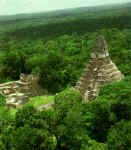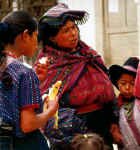
|
Ruins, Tikal Nat'l ParkPhoto: José Carlos Flores |
|
Ruins, Tikal Nat'l ParkPhoto: José Carlos Flores |
Exactly what led to the collapse of Old Maya civilization remains a mystery, but today's Maya people retain many of the cultural traits associated with their ancestors. Maya culture permeates contemporary Guatemala, where two dozen Maya languages are spoken by more than 4 million people. Native traditions, such as agriculture, weaving and the count of days in the Maya calendar, have survived the influence of Spanish culture, missionaries, radio, television, and, most recently, globalization and the Internet.
Visitors to Guatemala's museums, archaeological sites, markets and towns will find themselves immersed in a living Maya culture, witnesses to the history of a complex and fascinating civilization that began more than 2,000 years ago and continues to this day.
POPOL VUH
In the 16th century, an anonymous, native Guatemalan author wrote the country's greatest literary work, now known as the Popol Vuh, or the Sacred Book of the Ancient Maya Quiché. The book relates the history of the Maya-Quiché people, from the beginning of time, when the earth and human beings were created, to the moment of the Spanish conquest.
Sylvanus G. Morely, an authority on the Maya, has written that the Popol Vuh "is, beyond any shadow of doubt, the most distinguished example of Native American literature ... it is written in an exalted and elegant style, and is an epic of the most distinguished literary quality."
In the opening pages of the story, the creators Gucumatz and Tepeu, hidden under green and blue feathers beneath the water, decide to create earth, light, mountains, trees and animals. Then they try their hand at making men and women. First they attempt to make man of mud, but "he did not move, had no strength, he fell down, he was limp, he could not move his head, his face fell to one side."
The mud men were destroyed, and a second attempt was made with wood, "but they did not have souls, nor minds, they did not remember their Creator; they walked on all fours, aimlessly." Finally, the Creators hit on the magic formula of using corn dough (to this day, Guatemala's dietary staple), and the new humans "conversed, saw and heard, walked, grasped things... they were endowed with intelligence."
The stories of the Popol Vuh had undoubtedly been passed from generation to generation of the Maya, both orally and by written hieroglyphics. Today they constitute a rich legacy for archaeologists, piecing together the Cosmo vision of the Old Maya, for Guatemalan artists, who frequently return to the Popol Vuh for inspiration in their paintings, sculptures and literature, and for everyone who is interested in learning more about this fascinating civilization.
ARCHAEOLOGY
In the 19th-century, scientists began to explore the ruins of Old Maya cities, and have since painstakingly deciphered hieroglyphic accounts of their histories. One of the milestones in this work was the discovery that some hieroglyphs are used as phonetic markers for words from a language similar to those spoken by contemporary Maya. Guatemala's written history dates from the first century BC, when the Maya carved the earliest, dated inscription found so far in the country.
Stelae, Ruins of QiriguáPhoto: Juan Carlos Lemús Dahinsten |
The history left to us by the Maya, carved on door lintels, Stelae, altars, and staircases or written on paper made of tree bark, records the rise and fall of kings, triumphs in war, and astronomical observations. Maya history is usually divided into Pre-Classic (600 BC - 250 AD), Classic (250 - 900 AD) and Post-Classic (from 900 AD). The city of Tikal, where continuous construction occurred for more than 1,100 years, began in Pre-Classic times, reached the height of its glory in the Classic era, and collapsed, for unknown reasons, in about 900 AD.
The Tikal National Park lies within the Maya Biosphere Reserve, 3.9 million acres of protected forests and wetlands that comprise 19% of the Guatemala's land area and 50% of its existing forests. The reserve contains the largest, intact, tropical forest in Central America, as well as more than 200 archaeological sites, all Maya, including Tikal, El Mirador, Yaxhá, Uaxactún and Dos Pilas. Visitors to Tikal and the Maya Biosphere will see not only pyramids that tower above the forest canopy, but the wildlife that provided inspiration for Maya art and mythology. Fifty-four mammal species, including howler and spider monkeys, anteaters, armadillos, coatis, kinkajous, pumas, jaguars and tapirs still inhabit the forest once inhabited by the Maya, as do 333 species of birds, including toucans, macaws and Oscillated Turkeys.
Many archaeological sites are found in Guatemala's highlands area as well. Some of these, such as Zaculeu, Iximché, and Gumarcaaj, were thriving cities when Spaniards arrived, the capitals of what were effectively small nations occasionally at war with each other. In Post-Classic times, Meso-American populations began a complex series of migrations, and Guatemala's highlands people were heavily influenced by neighboring Mexican cultures. But, despite these influences, they shared many cultural traits that are distinctly Maya, including the languages that are still spoken today. Their mythology, such as that recorded in the Popol Vuh, has helped scientists understand beliefs of earlier Maya people who inhabited cities such as Tikal.
Along the country's Pacific coast, archaeologists have found vestiges of the Olmec civilization, a culture that pre-dated the Maya. The Olmecs were perhaps the first culture in Meso-America to construct pyramidal buildings and their construction techniques were undoubtedly passed down to the Maya. A distinctly Olmec art form, round boulders carved with human or zoomorphic features can be observed at some of Guatemala's coastal sites. At one site, Abaj Takalik, a mixture of Olmec and Maya art forms has been unearthed.
THE CONQUEST AND TECUN UMAN
The Spanish conquest of Guatemala's Maya people began in February 1524, when conquistador Pedro de Alvarado led an army of Spaniards and Mexican natives into the highlands and met a Quiché army at what is today Quetzaltenango.
It was neither superior tactical ability nor weaponry that decided that battle and led to the eventual conquest of Guatemala's native population, but European diseases that traversed the Atlantic with the Spaniards and decimated Guatemala's native population four years before conquistadors arrived. The terrible story of the plagues was recorded by Guatemala's Maya-Chkchiquel people. "After our fathers and grandfathers succumbed, half of the people ran away from the towns. Dogs and vultures devoured the bodies. The mortality was terrible... That is how we became orphans, oh, my children!"
The Spaniards almost certainly encountered an army of young, inexperienced fighters, fielded from a population that had not begun to recover from the devastating effects of the plagues. This native army was led by a gallant Maya-Quiché captain, Tecun Uman, attired in quetzal feathers and wearing crowns of precious metals and jewels. A Quiché chronicle, written in the 1550s, tells how Captain Tecun "became an eagle covered with real feathers that sprouted from his body. He had wings that also sprouted from his body and three crowns--one of gold, another of diamonds, and a third of emeralds."
The authors describe how Tecun Uman rose in flight to attack Pedro de Alvarado, who pierced him in the breast with his spear. They tell how the conquistador "called all his soldiers to come and see the beauty of this quetzal Indian. He told them he had not seen another Indian so handsome and regal and so full of quetzal feathers and so beautiful, not in Mexico, nor in Tlascala, nor in any other town they had conquered. And so Alvarado said that the name of this place would be Quetzaltenango (the 'place of the quetzals')."
Today a statue of Tecun Uman stands at the entrance to Quetzaltenango, fiercely guarding the road climbed by the Spaniards into the Guatemalan highlands, where their conquest of the Maya began. The last Maya city to be conquered belonged to the Itzá, on the island where the town of Flores is now found in Guatemala's Petén department, near the abandoned city of Tikal.
 |
|
Dancer of San Juan ComalpaPhoto: José Carlos Flores |
THE LIVING MAYA
Today in Guatemala, two dozen Maya languages are spoken, belonging to five main language groups: Quiché, Mam, Qanjobal, Chol and Yucateca. These language groups are believed to have evolved from a "Protomaya" language that was spoken in the mountainous Cuchumatán region of Guatemala 4,000 years ago.
For a large percentage of Guatemala's inhabitants, Spanish is a second language, and in some areas of the country, many people do not speak Spanish at all. About 40% of the population, more than 4 million Guatemalans, speak a Maya language. One of the goals of the 1996 Peace Accords is to provide educational and legal services in both a native language and Spanish for this population. In town markets, buses, restaurants, and streets throughout Guatemala, visitors will frequently overhear conversations in one of Guatemala's living Maya languages, spoken for millennia by the country's inhabitants.
No matter what native language they speak, Guatemala's Maya people share a number of other cultural traits. One of the most remarkable of these is the faithful count of days according to the Maya calendar. For the Maya, their calendar was, and still is, inseparable from daily life, guiding them in making decisions such as when to plant, harvest, pray or sell their products. The ritual calendar, called the Cholq'ij, consists of twenty named days preceded by numbered prefixes from one to thirteen. The combination of the twenty days and 13 numbers gives a ritual calendar of 260 days. In disparate communities of Guatemala and Mexico, this calendar is perfectly synchronized, like a heart that has never missed a beat, a remarkable testament to its importance for the Maya people.
Corn was the crop that allowed civilization to develop in the Americas, and many experts place the origin this all-important foodstuff in Guatemala. Maya life was, and still is, intricately linked to the planting and harvesting of corn, a staple in the Guatemalan diet for thousands of years. In the months of February and March, just before the beginning of the rainy season, Guatemalan farmers will be seen hoeing their milpas, or corn fields, and planting seed carefully saved from the last harvest. In October and November, mounds of husked yellow, white and blue-black corn dry in the sun outside houses, awaiting storage and its eventual use in making tortillas. The corn is cooked, according to an ancient formula, in water with limestone to soften the kernels, ground into dough and patted by hand into soft tortillas, which are cooked on an iron griddle and served with virtually every meal, accompanied by other traditional American foods, such as beans and chile.
|
Woman of Santiago AtitlánPhoto: José Carlos Flores |
|
Man of HuehuetenangoPhoto: Juan Carlos Lemús Dahinsten |
Other traditions conserved by the Maya include preparation of cotton threads and the weaving of their own clothing using back-strap looms. Everywhere in Guatemala, visitors will see women (and, in many regions, men) wearing colorful, hand woven clothing in a beautiful array of designs and colors. In every market, these unique textiles can be purchased, along with an incredible assortment of other hand-made crafts. Many other Maya traditions persist among Guatemala's native people, which visitors who travel to highlands towns such as Santiago Atitlán, Chichicastenango and Quetzaltenango will have ample opportunity to observe.
Guatemala is the place where corn was first cultivated, where gods made the first men from corn dough, where Maya languages developed and where the Maya's greatest cities flourished. In Guatemala, the Maya live on, speaking languages that have endured for thousands of years, keeping their faithful count of days in the Cholq'ij calendar, and tilling ground that has provided sustenance for innumerable generations. Historically, culturally, archeologically, Guatemala is the center of the Maya universe and the heart of the Maya world.